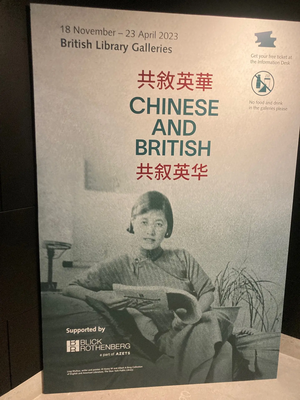The Chinese and British Exhibition at the British Library

The Exhibition describes that the Chinese have been present in Britain and have played an active role in its society for over 300 years.
People of Chinese heritage can trace their origins to the various regions of east and south east Asia. These diverse backrounds have resulted in a rich and varied culture across the whole of the UK.
From wartime service, the nation's cuisine to achievements in science, literature, music, fashion, commerce, sport etc. the British Chinese people have had a lasting impact on the UK's culture. Today, the British Chinese population is larger than ever and increasing with the BNO visa holders from Hong Kong arriving in the UK. It is estimated that there are presently more than 500,000 people of Chinese heritage living in Britain.
This exhibition charts the history of the Chinese population through personal stories and times of national importance to seek: What does it mean to be Chinese and British?
Michael Alphonsus Shen Fuzong, a Catholic convert and intellectual arrived in 1687 and is the first recorded individual from China. In 1770's the first Chinese Scotsman a William Macao lived and worked in Edinburgh for over 50 years. In 1805 a John Anthony became the first Chinese person to be naturalised British through an Act of Parliament. Others followed over time and it wasn't until the 1880's due to the trade with China a small Chinese community grew around the docks in Limehouse in East End of London. These Chinese people settled, set up businesses and created the first Chinatown. To a lesser degree the ports of Liverpool, Newcastle and Cardiff generated small Chinese communities.
It wasn't until the mid 20th century that increasing number of persons of Chinese heritage came to Britain. In the 1950's to 1960's due to its strong trade connections with Hong Kong many of its citizens mostly with connections to mainland Canton (Guangzhou) arrived in Britain. An influx of Malaysian and Singaporean citizens arrived after these counties gained independence from Britain and in 1978 due to the war in Vietnam an influx of the Vietnamese refugees and migrants (boat people) many with Chinese heritage arrived in Britain.
The difficulties in finding work as immigrants in the early 20th century led many Chinese arrivals into industries such as merchant shipping and laundries which was a tough and demanding work. Later, many moved into catering with jobs in restaurants and takeaways being a common experience. As well as a source of income, these small businesses were and still are centres of community and an important part of the make-up of many cities, towns and villages.
Many British Chinese people have excelled in careers such as science, Medicine, law and politics. Now, British Chinese people make their living across every kind of profession and vocation.
Discrimination towards the Chinese is displayed. For example, a strike in 1911 led by the National Sailors and Firemen's Union culminated in violence against Chinese businesses in Cardiff. Fearing that the settlement of Chinese sailors in Britain would undercut wages, racial conflicts erupted during the strike. People smashed windows of Chinese owned laundries despite these businesses them having no direct connection with shipping.
The "Forced repatriation of Chinese sailors" is documented. At the end of the two World War thousands of Chinese seamen who had contributed to the war effort remained in Liverpool. Concerned that they would stay permanently, the government devised a plan to return them to China. The Police and Immigration Services rounded up Chinese seamen under false pretences and deported them. The men were told they would be unable to return to the UK. Many men who had married and had children never saw their families again. A photograph of the 2006 plaque situated in Liverpool docks of the Memorial to the repatriated sailors is displayed and an acknowledgement that in 1922 the Home Office released an internal report into the affair acknowledging the coercion and racial element to the repatriation programme.
Examples of successful Chinese persons from the world of science, engineering, arts, music, literature, sports are mentioned. There are films with sound, photographs, artefacts and anecdotes from a bygone age of everyday life of the Chinese British of the past can be seen.
The exhibition gives the audience a snap shot of what it is like to be and have been Chinese and British over the past 300 years.
This free exhibition is open until the 23rd April 2023.
